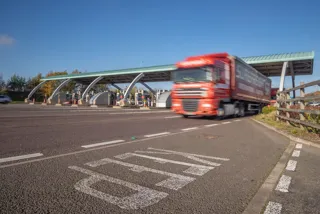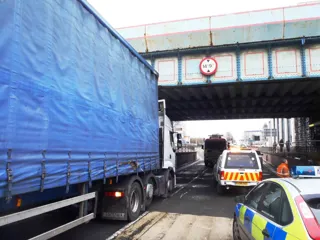All new vans and trucks will have to be equipped with certain advanced driver safety systems by 2022 under new European-wide rules approved last month.
Policymakers hope the measures will significantly reduce the number of fatalities and severe injuries on the roads.
Under the regulations, all vehicles (including trucks, buses, vans and cars) will have to be equipped with speed limiters and the wiring for in-built breathalysers.
It is yet to be confirmed if the UK will implement the regulations after Brexit, although the Government has previously said the UK will mirror European road safety rules. All this is, of course, subject to the outcome of the general election.
Vehicle manufacturers will also have to fit driver distraction warning systems, reversing detectors, accident data recorders and tyre pressure monitoring devices.
Vans and cars have the additional requirement of being fitted with autonomous emergency braking (AEB) and lane-keeping systems, as well as enlarged head impact protection zones capable of mitigating injuries in collisions with vulnerable road users, such as pedestrians and cyclists.
The European Council rubber-stamped the plans for the safety measures after the European Parliament had given its approval in March.
Timo Harakka of the European Council, said: “The new rules will help us to reduce significantly the number of fatalities and severe injuries.”
Road safety organisation the European Transport Safety Council (ETSC) estimates the measures could cut collisions by 30% and save 25,000 lives across Europe over the next 15 years.
The new rules also say trucks and buses must be designed and manufactured in such a way that the blind spots around the vehicle are significantly reduced. Furthermore, they will have to be equipped with advanced systems capable of detecting pedestrians and cyclists located in proximity to the vehicle.
The measures reflect the Direct Vision Standard (DVS) being introduced in London from October 26, next year.
Based on how much a driver can see directly through their cab windows, DVS employs a star system which rates HGVs over 12 tonnes from zero (lowest) to five (highest).
DVS requires HGVs operating within the Greater London boundary to meet a minimum ‘one-star’ rating or for operators to fit ‘Safe System’ measures to improve vehicle safety.
Vehicles rated between one and five stars will be compliant until 2024, when vehicles two stars and below will require a ‘Progressive Safe System’ in order to operate in London (subject to consultation).
Commercial fleets operating within the M25 are being urged to apply now for a HGV safety permit so they can continue to use their vehicles in London.
As part of the process for the new EU vehicle safety rules, researchers from TRL – the UK-based Transport Research Laboratory – conducted a cost-benefit evaluation of the next generation of vehicle safety standards.
Richard Cuerden, head of TRL’s Academy, said: “Intelligent speed assistance and drowsiness and distraction recognition will support drivers in their ongoing tasks. AEB and emergency lane-keeping will intervene in the most critical situations to avoid a crash, and improved crash tests will ensure injuries of occupants as well as pedestrians and cyclists are minimised in the remaining collisions.”
Intelligent speed assistance uses traffic sign recognition and/or GPS location data to determine local speed limits. It then caps engine power to prevent the car accelerating above that limit.
The system can be overridden by the driver pressing hard on the accelerator and the ETSC has suggested that there should initially be an on/off control to completely deactivate it.
Details of how the breathalyser system will work are yet to be revealed, but it is thought they will be aimed at tackling repeat offenders.
Systems in use in countries such as Australia and the United States use breathalyser technology similar to police and home testing kits.
They require drivers to provide a clear breath sample via a built-in unit before allowing the engine to start.
They can then require additional samples at random intervals to stop drink-drivers from getting a sober friend to provide a sample.
Joshua Harris, director of campaigns at the road safety charity Brake, said: “Drink-driving and speeding are a scourge on our roads and the cause of devastating crashes every day.
“It’s fantastic to hear that alcohol interlock compatibility and speed limiting technology will soon be mandatory.”
New vehicles will also be required to be fitted with electronic data recorders that store data on the car’s status in the moments immediately before a collision. Such information is vital to understanding why crashes occur and for preventing future collisions.
Volkswagen Commercial Vehicles, which has AEB as a standard fit across its van range, says that fitting the safety system on all vans in the UK has the potential to stop almost 2,500 crashes per year.
Analysis of Department for Transport van accident statistics reveals 2,496 incidents involving vans weighing up to 3.5 tonnes could have been avoided if AEB had been fitted – preventing 348 deaths and serious injuries.
AEB systems also have the potential to cut third party insurance claims by 45%, meaning lower costs and less time off the road for van drivers and fleet operators.
Vehicles fitted with AEB also benefit from an average insurance premium saving of 10% compared with those without.
Matthew Avery, director of research at Thatcham Research, said: “With the number of accidents involving vans increasing year on year, AEB’s proven ability to avoid and mitigate collisions should not be overlooked.”























Armstrong - 08/12/2019 11:31
As Part of my Duties driving varied LGV’s,Blind spots created by cab A posts and excessive large wing mirror designs,Has become an increasing challenge .It is commendable that legislation is been implemented to address this design failure. Lane change warning :Can pick up false readings from road surface other than marked lines.Automatic collision braking:I have experienced this on an articulated vehicle,No vehicles to the front of my vehicle,My vehicle maintaining same lane position,Quite unexpected put brakes on for circa 3secs.Possibly detected vehicle moving to close to the side of my vehicles.Sensors on vehicles are affected by sleet and snow.